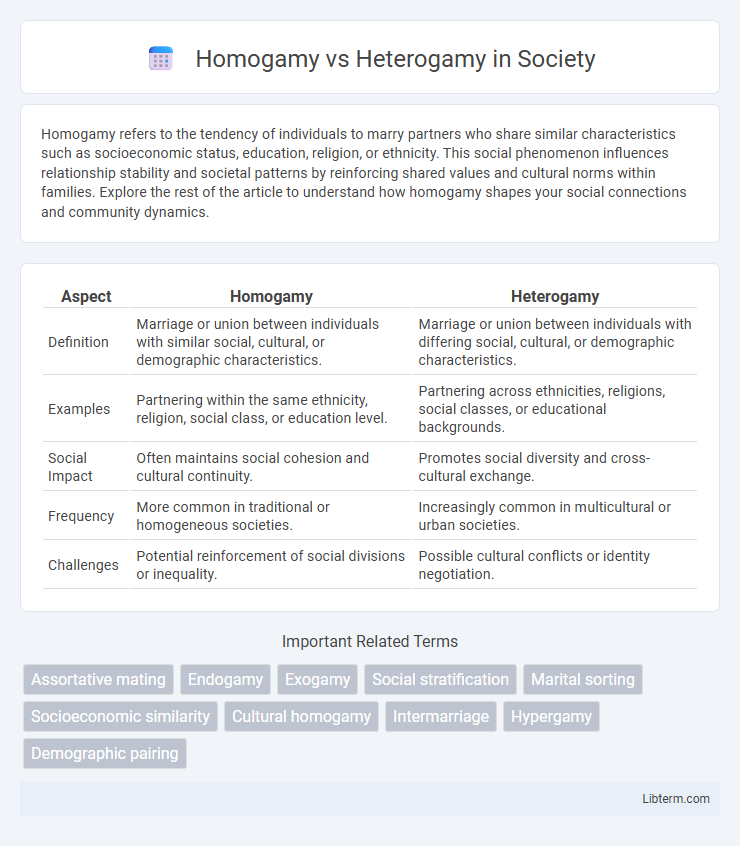Homogamy refers to the tendency of individuals to marry partners who share similar characteristics such as socioeconomic status, education, religion, or ethnicity. This social phenomenon influences relationship stability and societal patterns by reinforcing shared values and cultural norms within families. Explore the rest of the article to understand how homogamy shapes your social connections and community dynamics.
Table of Comparison
| Aspect | Homogamy | Heterogamy |
|---|---|---|
| Definition | Marriage or union between individuals with similar social, cultural, or demographic characteristics. | Marriage or union between individuals with differing social, cultural, or demographic characteristics. |
| Examples | Partnering within the same ethnicity, religion, social class, or education level. | Partnering across ethnicities, religions, social classes, or educational backgrounds. |
| Social Impact | Often maintains social cohesion and cultural continuity. | Promotes social diversity and cross-cultural exchange. |
| Frequency | More common in traditional or homogeneous societies. | Increasingly common in multicultural or urban societies. |
| Challenges | Potential reinforcement of social divisions or inequality. | Possible cultural conflicts or identity negotiation. |
Understanding Homogamy: Definition and Key Concepts
Homogamy refers to the practice of individuals marrying or forming relationships with partners who have similar characteristics such as ethnicity, religion, socioeconomic status, or education level. This concept emphasizes social integration and cohesion by promoting shared values and cultural backgrounds within couples. Understanding homogamy highlights how similarity in key traits influences relationship stability and social networks.
Heterogamy Explained: Meaning and Characteristics
Heterogamy refers to a marital or romantic relationship between individuals who differ significantly in social, cultural, or demographic variables such as age, ethnicity, religion, or socioeconomic status. This type of union often embraces diversity and can challenge traditional norms by combining distinct backgrounds and perspectives. Characteristics of heterogamy include increased exposure to varied cultural experiences and potential for broader social networks, while sometimes facing societal resistance or adjustment challenges.
Historical Perspectives on Marriage Patterns
Historical perspectives on marriage patterns reveal that homogamy--the practice of marrying within a similar social, ethnic, or cultural group--has traditionally maintained social cohesion and reinforced shared values within communities. In contrast, heterogamy, the union of individuals from different social or cultural backgrounds, has often been viewed as a challenge to established norms and sometimes faced social resistance. Over time, shifts in economic, political, and cultural landscapes have influenced the prevalence of homogamous and heterogamous marriages, reflecting evolving societal attitudes toward diversity and integration.
Cultural Influences on Partner Selection
Cultural norms significantly shape homogamy by encouraging individuals to choose partners with similar social backgrounds, religious beliefs, and ethnicities, reinforcing social cohesion and identity. In contrast, heterogamy challenges traditional boundaries by promoting unions across different cultures, fostering diversity and social integration. Patterns in partner selection reveal how cultural values influence preferences for similarity versus diversity within relationships.
Social and Economic Factors in Homogamy
Social and economic factors significantly influence homogamy, where individuals tend to partner with those of similar social class, education level, and economic status. Shared values, lifestyle preferences, and economic stability promote relationship compatibility and collective social mobility within homogamous unions. These factors reinforce social cohesion and reduce conflicts related to financial disparities and cultural differences.
Psychological Aspects of Heterogamous Relationships
Heterogamous relationships, characterized by partners differing in social or cultural backgrounds, often face unique psychological challenges such as identity negotiation and value conflicts. These relationships require heightened communication skills and emotional resilience to manage differences in beliefs, traditions, and social expectations. Research indicates that successful heterogamous couples develop adaptive coping strategies that promote mutual understanding and psychological well-being.
Benefits and Challenges of Homogamy
Homogamy, the practice of marrying someone with similar social, cultural, or demographic traits, promotes stronger compatibility and shared values, leading to greater relationship stability and mutual understanding. Benefits include easier communication, aligned goals, and reduced conflicts due to common backgrounds and interests. Challenges arise in limited diversity, potential social insularity, and reduced opportunity for personal growth through exposure to different perspectives.
Pros and Cons of Heterogamy
Heterogamy, the practice of marrying or partnering with someone from a different social, cultural, or ethnic background, promotes genetic diversity and broadens social networks, enhancing adaptability and social integration. However, it may also introduce challenges such as cultural misunderstandings, value conflicts, and potential social disapproval, which can strain relationships. Successfully navigating heterogamous unions often requires strong communication skills, open-mindedness, and mutual respect to overcome these obstacles.
Impact on Family Dynamics and Society
Homogamy, the practice of marrying within similar social, cultural, or economic groups, tends to promote family stability and shared values, reinforcing social cohesion and predictable family roles. Heterogamy, involving unions between individuals from diverse backgrounds, can introduce broader perspectives and adaptability but may also face challenges related to cultural integration and social acceptance. These patterns significantly shape societal structures by influencing social capital distribution, intergroup relations, and the evolution of social norms.
Future Trends in Homogamy and Heterogamy
Future trends in homogamy indicate a gradual shift as increasing globalization and digital connectivity promote more heterogamous relationships across cultural, ethnic, and socioeconomic boundaries. Advances in social media algorithms and online dating platforms facilitate greater diversity in partner selection, challenging traditional homogamous patterns commonly seen in education, religion, and ethnicity. Despite these changes, homogamy may persist in certain regions due to enduring social norms, but overall, the trajectory suggests rising heterogamy driven by evolving societal values and increased intercultural interactions.
Homogamy Infographic

 libterm.com
libterm.com